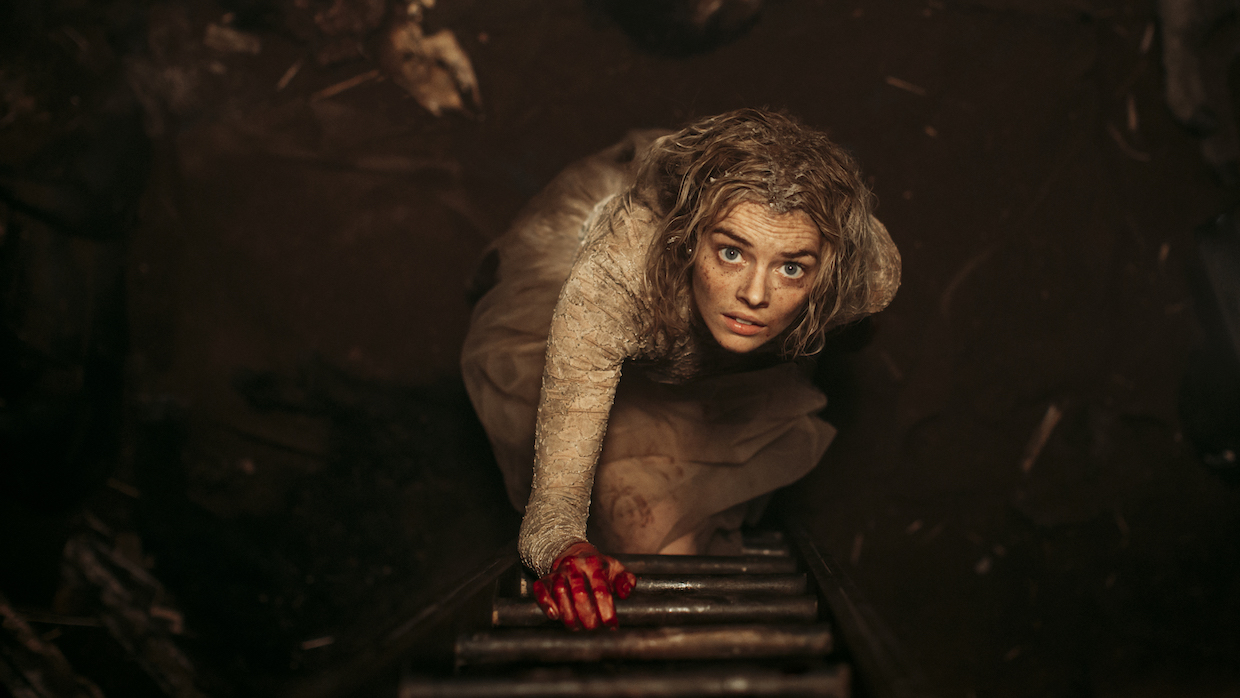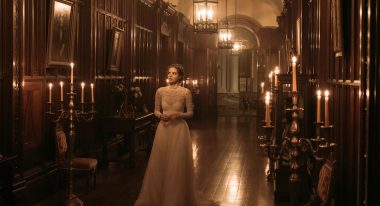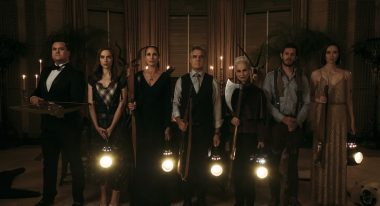 Back to selection
Back to selection
Shutter Angles
Conversations with DPs, directors and below-the-line crew by Matt Mulcahey
“Imagine Making a Movie Without Tape”: DP Brett Jutkiewicz on Ready or Not
 Samara Weaving in Ready or Not (Photo by Eric Zachanowich)
Samara Weaving in Ready or Not (Photo by Eric Zachanowich) In Ready or Not, a bride spends her wedding night playing a deadly game of hide and seek with her new in-laws, a clan of board game magnates beholden to a curse that requires them to dispose of the newlywed before dawn. The film unfolds almost entirely at the wealthy family’s estate, an opulent expanse shot mainly at the historic Parkwood Estate near Toronto.
Ready or Not’s $6 million budget and 26-day shooting schedule are modest for a wide theatrical release, but for cinematographer Brett Jutkiewicz the scale is downright gluttonous compared to past efforts like Benny and Josh Safdie’s feature debut Daddy Longlegs, Sundance entry Them That Follow and the micro-budget Civil War drama Men Go to Battle. Jutkiewicz spoke to Filmmaker about making that leap, his allergic reaction to movie moonlight and splattering gore around a Canadian YWCA.
Filmmaker: What was the process of getting on Ready or Not? It’s a step up in scale for you.
Jutkiewicz: My agent got the script and I had so much fun reading it. I’m not super well versed in the horror genre, but the ones I enjoy tend to be more in the vein of black comedy. I’m a fan of Eastern European directors like Zulawski, Polanski, Kieślowski or even Kaurismäki—dark deadpan humor that can have elements of horror. Polanski’s The Tenant is one of my favorite films of all time. Ready or Not is tongue in cheek and doesn’t take itself too seriously, but it’s still scary and engaging. I thought it would be a blast to shoot. I ended up Skype-ing with the Radio Silence guys (the filmmaking collective comprised of directors Tyler Gillett and Matt Bettinelli-Olpin and producer Chad Villella), we got along really well and they hired me to shoot the movie.
Filmmaker: You have an interesting background in that you initially worked as both a cinematographer and an editor. How did you end up in those dual roles?
Jutkiewicz: It really started with making videos as a kid. I was always using a video camera for something. I shot a lot of skateboarding videos. For school projects I’d always try to convince my teacher to let me make a video instead of writing a report, and I would edit everything I shot. In college, I cut my own student films and also some projects that I shot for other people. Being able to do both was just always something that made sense to me. I liked having that control over what wound up in the movie, but cinematography was always what I was most passionate about.
When I moved to New York after graduating, I edited a few of the films I shot, and other people would ask me to cut stuff I didn’t shoot as well. Being in my early 20s in New York and trying to make a living and pay my rent, it was helpful to be able to edit when I wasn’t shooting or shoot when I wasn’t editing. It was another source of income, but after a while as I shot more and more I let the editing fade away.
Filmmaker: Do you find that your experience as an editor changed the way you approach coverage as a cinematographer?
Jutkiewicz: Absolutely. While I always want to make beautiful images that tell the story and reinforce the emotions of the scene, I’m also very aware of how things are going to fit together in the edit and what’s going to match.
Filmmaker: Was your prep process different on Ready or Not than previous films? You’re dealing with a new level of action sequences and practical effects.
Jutkiewicz: I always do comprehensive shot lists but, yeah, for this we did a good bit of storyboarding for the stunt sequences, more so than I would usually do. Our budget was tight, so the art department needed to know exactly what we were going to be seeing from which angles. For example, in the scene where [the bride, played by Samara Weaving] tries to squeeze through the [estate’s fence, the art department only had to build a 30-foot section of the fence that was then extended digitally by the VFX people.
Filmmaker: Did you get to operate on this one?
Jutkiewicz: I didn’t.
Filmmaker: Was that difficult to let go of?
Jutkiewicz: I love operating the camera. I operated on all of my previous features, but I was pleasantly surprised [by the process of not operating on Ready or Not]. We were using two cameras most of the time, so it was important for me to be able to watch both cameras at the same time and not have to shoot mine and then watch playback for B-camera. It really helped me to be able to focus on the lighting, which was complicated. We were also bouncing around in our locations. We’d set up the A-camera for a scene and the B-camera would be setting up for the next scene in another room. So, I’d be bouncing back and forth between the two sets.
Filmmaker: You’ve used Cooke lenses on your last few features. What do you like about the Cookes?
Jutkiewicz: I think they’re great looking lenses and I love the way the focus falls off very gradually. For Ready or Not we used the Cooke S5’s, which are significantly more modern and sharp than the vintage Cooke Speed Panchros I used on Men Go to Battle.
Filmmaker: For Men Go to Battle you used a lot of homemade fixtures. Did any of those DIY lights make their way onto Ready or Not?
Jutkiewicz: No, nothing survived. Most of those barely made it to the end of that shoot. I do think working with candlelight on that movie definitely informed how I lit Ready or Not in terms of understanding how a fire flickers versus how a candle flickers and the color temperature difference between the two. Also, since (Men Go to Battle), LEDs have come a long way. On that movie we were using an array of household bulbs on different circuits that were on a flicker box, but now we just put up a SkyPanel and turn it on fire mode and dial it in.
Filmmaker: Tell me about the specifics of mimicking candlelight. In Ready or Not, the candles are motivating the light in some cavernous rooms.
Jutkiewicz: A big part of our camera testing was throwing up a candelabra with some real candles on it on one side of the subject’s face, then taking our LED lights on the other side of their face and going through the color spectrum to find out exactly what [LED settings] matched the color coming off of the candlelight. We got pretty close, but there’s still something about real firelight that an LED can’t totally replicate. For the bigger rooms, we were basically putting a lot of candles in there, then wrapping LED tubes all around the room high out of frame to create the effect of ambient candlelight bouncing all around.
Filmmaker: What about the lanterns that the family members carry?
Jutkiewicz: Those were old railroad signal lanterns that the art department sourced. We gutted them and my gaffer, Randy Brown, put in these little LED battery powered spotlights that we gelled to match the color of the candlelight. They were battery powered and dimmable, though most of the time we used them full up. We also put diffusion inside of the lantern’s glass front.
Filmmaker: Let’s get into the locations a little bit. So the family room where the game of hide and seek begins, that was shot at a YWCA. Was it just an empty room that you dressed or was this an unusually ornate YWCA?
Jutkiewicz: All the furniture was brought in by the art department, but the built-in cabinets and the molding were already there. It was this old building in Oshawa outside of Toronto. I don’t know exactly what they used that room for. That was the only location where we were allowed to do practical blood splatter. The other locations we used for the house wouldn’t allow it so we had to find an alternative—and we found it in a YWCA in Oshawa. (laughs)
Filmmaker: What were the pros and cons of shooting so much of the movie at the Parkwood Estate as opposed to doing interiors on a stage?
Jutkiewicz: Well, one of the pros was that we could afford it. (laughs) That was probably the biggest pro. That location had all of this built-in character, things that we never would have thought to build or have been able to afford to build on set. It’s brief in the film, but there’s a little bowling alley in Parkwood and this spiral staircase with a beautiful glass dome over it. I find a lot of inspiration from practical locations. I like to walk into a space and look around and get a feeling for how that place wants to be shot.
Filmmaker: Were there restrictions for shooting at a historic landmark like Parkwood?
Jutkiewicz: Oh, so many restrictions. We couldn’t use tape—imagine making a movie without tape. We couldn’t rig to anything. It was really difficult. Normally if I need a little light somewhere I’d just take an LED tube and tape it to the wall, but we couldn’t do that. It was definitely an exercise in creativity. We had so many scenes that we were looking 360—like the music room scene in the beginning of the film, where we choreographed these long Steadicam shots. Finding ways to get everything out of the frame was a real challenge. We also couldn’t use atmosphere in Parkwood, which we fought really hard for. So, there was no haze. [The Parkwood Estate representatives] were great for having us there and they were helpful, but because it’s a historic place and they have artwork and tapestries that they obviously care about maintaining, it was a little bit of a dance to get things done in there.
Filmmaker: Let’s talk about the scene in the kitchen, where the bride hides from the family’s butler. It’s lit with cyan as opposed to the warm light that we get throughout the rest of the house.
Jutkiewicz: We were always looking for ways to break up how warm everything was. That’s also the kitchen at Parkwood. When we saw it early on in the scout, everyone thought it was too small to be the family’s kitchen, so we ended up playing it as the butler’s kitchen. When we first walked into that space it had this great stainless steel hood over the stove, which made me think we could go with a cool fluorescent look.
Filmmaker: You had a great quote in an old Filmmaker interview where you said “One of the most harrowing scene headings to read in a script for a low-budget film is “EXT. WOODS – NIGHT.” With a few more resources at your disposal here, how did you approach your night exteriors?
Jutkiewicz: Early on my gaffer Randy suggested we do a moonlight push for something and I said, “Randy, I hate moonlight in movies. We’re not doing any moonlight. Don’t even say the word ‘moonlight.'” He teased me about that the rest of the movie. Unless it’s really out in the middle of nowhere where there’s absolutely nothing that could illuminate a scene beside moonlight, I always look for something else that could be a motivating source. There are some lights outside of the house on the property, so I used them to motivate light whenever I could. Not to go on about moonlight, but it really bothers me when it’s pouring into the window. There are all these other lights in the room, but somehow this moonlight is at least as strong as the other lights in the room.
Filmmaker: I don’t know when you last saw John Carpenter’s original Halloween, but there is neon blue moonlight in that movie.
Jutkiewicz: Yeah, screaming blue moonlight. It’s not my thing. I try to avoid it and convince myself that there’s some motivating source somewhere else.
Filmmaker: One of the family members is given a vintage crossbow as a weapon and he turns to a tutorial video called “Getting to Know Your Crossbow” for assistance. What’s the story behind that video, which only plays for a few seconds but it pretty amusing? Are those the movie’s directors in there?
Jutkiewicz: Those two guys are actually the writers of the film. They made that video themselves and apparently it was like an hour long. (laughs) They did a whole video in those costumes.
***SPOILER ALERT***
Filmmaker: To finish up, let’s talk practical effects. Any good stories about practical gags from the movie?
Jutkiewicz: Well, definitely the exploding people at the end of the movie.
Filmmaker: That effect was practical? Obviously you didn’t really blow the actors up, but the splatter effect was practical?
Jutkiewicz: Yeah, it was a pyrotechnic exploding bag of fake blood and guts. All the cameras and the entire room were covered in plastic for that. We would shoot one pass with the actor and then another pass with the exploding bag on a chroma green stand that would [splatter] all over the room.
Matt Mulcahey works as a DIT in the Midwest. He also writes about film on his blog Deep Fried Movies.


